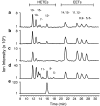Stimulation of rat erythrocyte P2X7 receptor induces the release of epoxyeicosatrienoic acids
- PMID: 17558440
- PMCID: PMC2042923
- DOI: 10.1038/sj.bjp.0707311
Stimulation of rat erythrocyte P2X7 receptor induces the release of epoxyeicosatrienoic acids
Abstract
Background and purpose: Red blood cells (RBCs) are reservoirs of vasodilatory, antiaggregatory, and antiinflammatory lipid mediators-epoxyeicosatrienoic acids (EETs). This study addresses the formation and release of erythrocyte-derived EETs in response to ATP receptor stimulation that may represent an important mechanism regarding circulatory regulation.
Experimental approach: Erythrocyte EET formation and release were investigated by incubating rat RBCs in physiological salt solution with agents that effected ATP release via P2 receptor stimulation of phospholipase A2 and epoxygenase-like activities with activation of the ATP secretory mechanism. EETs were analyzed by gas and liquid chromatography-mass spectrometry.
Key results: EETs were released from rat RBCs: 14,15-, 11,12-, 8,9- and 5,6-EETs in a ratio of 1.2:1.0:0.9:0.8. EETs were produced by epoxidation of arachidonic acid catalyzed by hemoglobin. Spontaneous release of EETs, 0.66+/-0.14 ng per 10(9) RBCs, was dose-dependently increased by an ATP analog, BzATP, and inhibited by P2X(7) receptor antagonists. 5 microM ATP increased release of EETs over 20% to 0.83+/-0.15 ng per 10(9) RBCs; 10 microM BzATP tripled the amount of EET release to 1.87+/-0.20 ng per 10(9) RBCs. EET release by ATP or BzATP was not associated with hemolysis. Carbenoxolone, a gap junction inhibitor that inhibits ATP release, and glibenclamide, an inhibitor of the cystic fibrosis transmembrane conductance regulator (CFTR), which is required for ATP release, inhibited the spontaneous and stimulated EET release from RBCs.
Conclusions and implications: EETs are produced and released from RBCs via a mechanism that is mediated by ATP stimulation of P2X(7) receptors coupled to ATP transporters, pannexin-1 and CFTR.
Figures







References
-
- Baraldi PG, Di Virgilio F, Romagnoli R. Agonists and antagonists acting at P2X7 receptor. Curr Top Med Chem. 2004;4:1707–1717. - PubMed
-
- Bergfeld GR, Forrester T. Release of ATP from human erythrocytes in response to a brief period of hypoxia and hypercapnia. Cardiovasc Res. 1992;26:40–47. - PubMed
-
- Brash AR, Boeglin WE, Capdevila JH, Yeola S, Blair IA. 7-HETE, 10-HETE, and 13-HETE are major products of NADPH-dependent arachidonic acid metabolism in rat liver microsomes: analysis of their stereochemistry, and the stereochemistry of their acid-catalyzed rearrangement. Arch Biochem Biophys. 1995;321:485–492. - PubMed
-
- Burnstock G, Knight GE. Cellular distribution and functions of P2 receptor subtypes in different systems. Int Rev Cytol. 2004;240:31–304. - PubMed
Publication types
MeSH terms
Substances
Grants and funding
LinkOut - more resources
Full Text Sources
Miscellaneous

